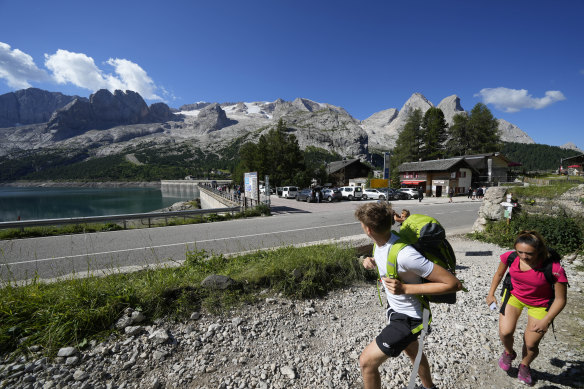
Punishing summer heat waves triggered the melt, but processes that initiated the rapid melt off began months ago.
The winter snowpack was lower than normal – only half the typical amount at the end of the season, Jacquemart said – limiting the growth of the glacier. For instance, Switzerland’s Gries Glacier recorded its lowest snow quantity on record at about 53 per cent below average in April.
At the end of winter and early spring, large plumes of dust from the Sahara coated the snow surface, darkening the glaciers. The darker surface absorbed more sunlight rather than reflecting it back into space, helping to warm what little snow had fallen.
Spring was also abnormally warm and dry for much of Western Europe, with little snow falling at high elevations on the glacier.
Then summer heat came in full force early on. South-west Europe reached its highest average May maximum temperature in 55 years of records. Then Europe experienced its second-warmest June on record.
“The combined heat and lack of precipitation have put the glaciers in a state that is unprecedented,” said Jacquemart, who also works at the Swiss Federal Institute for Forest, Snow and Landscape Research. It’s alarming because there isn’t just one glacier experiencing high melt, but “rather the fact that the situation is so bad everywhere in the European Alps,” she said.
Satellite data showed several glaciers shrinking after a heat wave in mid-June that brought temperatures 10 degrees higher than average in some regions. After about a week of unusually high temperatures, the Sabbione Glacier, which feeds into a hydropower reservoir, lost about 35 per cent of its snow cover, according to glaciologist Mauri Pelto.
Losing snow cover early in the melt season is problematic because bare glacier ice melts 50 per cent faster than if it were covered with snow. As heat waves continued, melting hastened in July.
“Glacier melt there in July was higher than the ever-recorded maximum for the full season,” Fischer said.
Satellite data shows significant melting of the Rhone Glacier, which feeds into the Rhone River, from June to July. By July 15, the snow line on the glacier was located at 2950 metres – about 150 metres higher than is typical for this time of the year.
Egli remembers running along a snow-covered ridge in the central Switzerland Alps with his dad when he was 12 years old. It was one of his first mountaineering adventures before he competed professionally. At the summit, he could see Zurich in the distance. Snow covered the summit slope facing the city even in the summer.
Loading
Two decades later, he visited to find the area was mainly rock and debris, the snow cover gone both on the ridge and the summit face. A glacier leading from the summit was now bare ice because temperatures have become too warm to retain the snowpack. Ice and firn, or dense snow leftover from previous seasons, also disappeared from the ridge.
Mountaineering practices have already changed in the past few decades in response, he said. Some routes are now only safe in April or May – before the trail becomes too dangerous.
Egli said he began to realise that “some of the glaciers we used to run over, they simply won’t exist any more”.
Fischer said the shifts coincide with long-term changes in the climate. Since the 1980s, the Alps have experienced an increase in temperature from 0.2 to 0.5 degrees Celsius per decade – significantly affecting snowfall and melt during the spring and summer.

Hikers walk past the Marmolada mountain near where 11 hikers died as glaciers melt and become more unstable.Credit:AP
“In the last two decades, the lack of summer snow got normal, and the melting season was getting longer and longer,” Fischer said in an email.
According to the Research Centre for Alpine Ecosystems, the duration of snow cover near the valley floor of the Northern Alps has been reduced by five weeks since the 1970s. By 2050, snow cover could be reduced by another four to five weeks.
Additionally, the number of hot days could increase by 15 to 30 days on the valley floor and in the mid-mountains. Today, the areas only experience two to five days of such temperatures.
“Northern Europe is a part of the globe which is projected to become warmer yet than the rest of the world,” said W. Tad Pfeffer, a professor at the University of Colorado at Boulder. “The Alps have been hit very hard. Glaciers are shrinking in Alaska, but not like the Alps.”
Loading
In rare cases, the rapid melt can spur exceptional events like the collapse of Marmolada Glacier in Italy’s Dolomites region. During a heat wave in July, a glacier chunk separated from the mountain and triggered an avalanche of ice, rock and debris below, killing 11 hikers.
“All glaciers in the Alps are suffering from heat and the melting processes are accelerated. In the Dolomites, the glaciers are generally smaller and thus more sensitive to climate change,” said Mauro Valt, a glaciologist at the Arabba Avalanche Centre.
Outside of the Alps, other mountainous glaciers have also experienced record melt. Glacier melt in Svalbard, Norway, saw its most melt on record during the first two months of the summer.
“We would not be seeing this in the absence of [human] influence on climate,” Pfeffer said. “Things that became kind of once-in-a-lifetime events started to become kind of routine ... We’re seeing the future.”
The Washington Post









 Add Category
Add Category